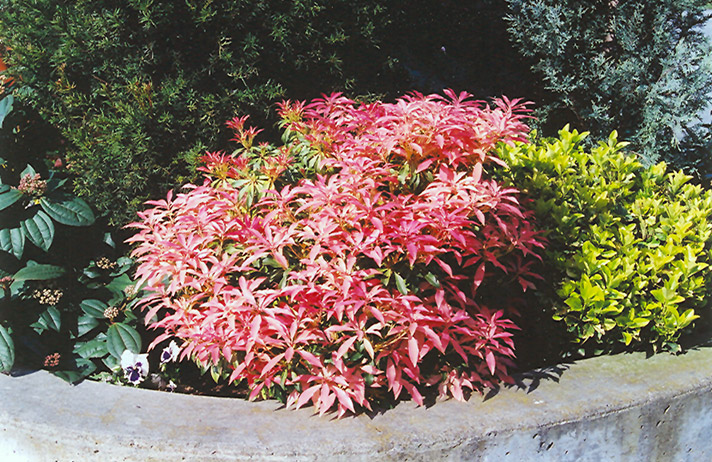The Plant Finder
Have a specific vision in mind for your outdoor space?
Search our database and find the perfect plants to meet your gardening needs.
Bert Chandler Japanese Pieris
Pieris japonica 'Bert Chandler'
Height: 5 feet
Spread: 5 feet
Sunlight:
![]()
![]()
Hardiness Zone: 6a
Other Names: Japanese Andromeda
Description:
A truly colorful broadleaf evergreen shrub which features unusual pink new growth which fades to white and eventually green, showy chains of white bell-shaped flowers, a distinctive compact mounded variety; performs best in moist, organic and acidic soils
Ornamental Features
Bert Chandler Japanese Pieris features dainty chains of white bell-shaped flowers hanging below the branches in early spring. It has attractive white-variegated green foliage which emerges pink in spring. The glossy narrow leaves are highly ornamental and remain green throughout the winter.
Landscape Attributes
Bert Chandler Japanese Pieris is a dense multi-stemmed evergreen shrub with a more or less rounded form. Its average texture blends into the landscape, but can be balanced by one or two finer or coarser trees or shrubs for an effective composition.
This shrub will require occasional maintenance and upkeep, and should only be pruned after flowering to avoid removing any of the current season's flowers. Deer don't particularly care for this plant and will usually leave it alone in favor of tastier treats. It has no significant negative characteristics.
Bert Chandler Japanese Pieris is recommended for the following landscape applications;
- Accent
- Mass Planting
- Hedges/Screening
- General Garden Use
Planting & Growing
Bert Chandler Japanese Pieris will grow to be about 5 feet tall at maturity, with a spread of 5 feet. It tends to fill out right to the ground and therefore doesn't necessarily require facer plants in front, and is suitable for planting under power lines. It grows at a slow rate, and under ideal conditions can be expected to live for 40 years or more.
This shrub does best in full sun to partial shade. It requires an evenly moist well-drained soil for optimal growth, but will die in standing water. It is very fussy about its soil conditions and must have rich, acidic soils to ensure success, and is subject to chlorosis (yellowing) of the foliage in alkaline soils. It is somewhat tolerant of urban pollution, and will benefit from being planted in a relatively sheltered location. Consider applying a thick mulch around the root zone in winter to protect it in exposed locations or colder microclimates. This is a selected variety of a species not originally from North America, and parts of it are known to be toxic to humans and animals, so care should be exercised in planting it around children and pets.

